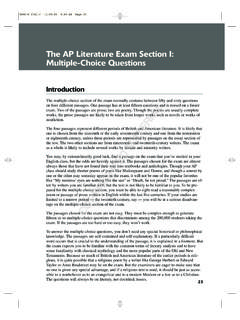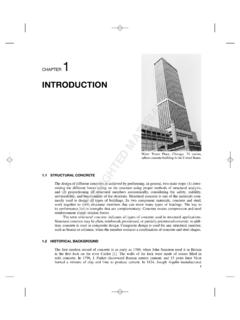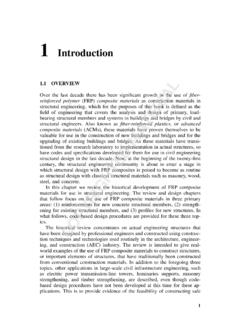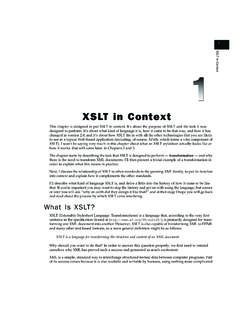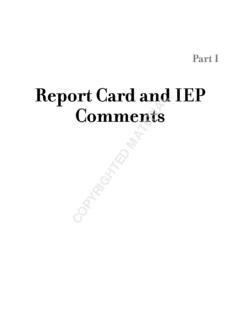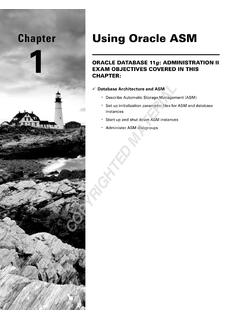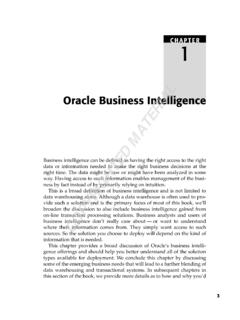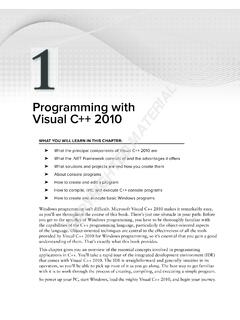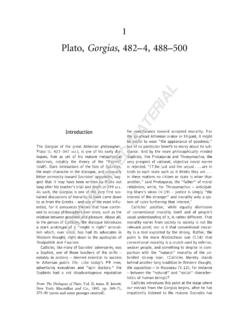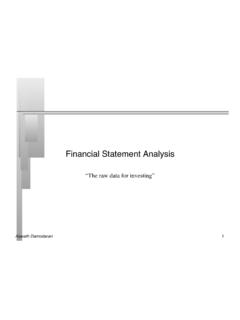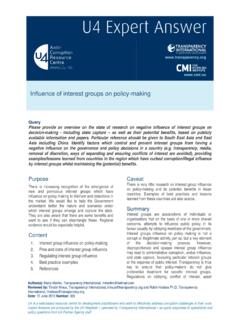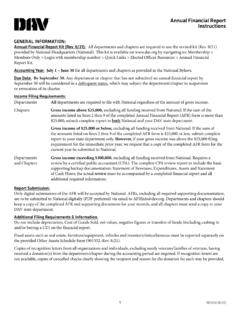Transcription of ACCOUNTING FOR REAL ESTATE
1 1 PART 1 ACCOUNTING FOR real ESTATE TRANSACTIONS GENERAL 13/6/08 9:53:51 PM3/6/08 9:53:51 PMCOPYRIGHTED 23/6/08 9:53:51 PM3/6/08 9:53:51 PM3 CHAPTER 1 ACQUISITION, DEVELOPMENT, AND CONSTRUCTION OF real ESTATE OVERVIEW ACQUISITION, DEVELOPMENT, AND CONSTRUCTION COSTS 5 Preacquisition Costs 6 Principles for the Capitalization of Preacquisition Costs 6 Capitalization of Internal Preacquisition Costs 8 Project Costs 9 Direct Costs 9 Indirect Costs 10 General and Administrative Expenses 12 Property Taxes and Insurance 12 interest 13 Cost
2 Allocation 16 Change in Estimates or Project Plans and Abandonments of Projects COSTS INCURRED TO SELL OR RENT A real ESTATE PROJECT 21 Costs Incurred to Sell a real ESTATE Project 21 Costs Incurred to Rent a real ESTATE Project INCIDENTAL OPERATIONS ACCOUNTING FOR COSTS INCURRED SUBSEQUENT TO PROJECT COMPLETION 25 Determining the Date of Project Completion 25 Costs Incurred Subsequent to Project Completion PURCHASE OF INCOME PRODUCING PROPERTY 27 Purchase of a Business 27 Purchase of an Asset /Asset Group 29 Recognition of Intangible Assets Acquired 29 Valuation of Land, Buildings.
3 And Intangibles 31 Allocation of Acquisition Cost 33 ACCOUNTING Subsequent to Acquisition SPECIAL ACCOUNTING ISSUES 36 Costs of Amenities 36 Start-Up Costs 38 Land Options 39 Financing as Part of aPurchase Transaction 43 Environmental Costs and Liabilities 44 Asset Retirement Obligations 45 Environmental Remediation Liabilities 47 Capitalizing versus Expensing of Environmental Remediation Costs 51 Transactions with Related Parties 52 Financing Provided by Related Parties 52 interest Capitalization on Investments Accounted for by the Equity Method 53 Purchase of real ESTATE from Party under Common Control 33/6/08 9:53:51 PM3/6/08 9:53:51 PM4 Chapter 1 Acquisition, Development, and Construction of real OVERVIEW Investments in real ESTATE projects require signifi cant amounts of capital.
4 For real ESTATE properties that are developed and constructed, rather than purchased, project costs include the costs of tangible assets, such as land and other hard costs (sometimes referred to as bricks and mortar ); intangible assets and other soft costs, such as architectural planning and design; and interest and taxes. Costs are often incurred before the actual acquisition of the project, which raises cer-tain questions for example, from what point in time should costs be capitalized? What types of costs are capitalizable? Determining what types of costs to capitalize in the preacquisition, acqui-sition, development, and construction stages of a real ESTATE project has been an issue for many years.
5 Several decades ago, the American Institute of Certifi ed Public Accountants (AICPA) issued the following ACCOUNTING guidance relating to cost capitalization, reacting to signifi cant diversity in practice: Industry ACCOUNTING Guide, ACCOUNTING for Retail Land Sales , issued in 1973 Statement of Position (SOP) 78 - 3, ACCOUNTING for Costs to Sell and Rent, and Initial Rental Operations of, real ESTATE Projects , issued in 1978 SOP 80 - 3, ACCOUNTING for real ESTATE Acquisition, Development, and Construction Costs , issued in 1980 In 1982, the Financial ACCOUNTING Standards Board (FASB) issued FASB Statement No. 67, ACCOUNTING for Costs and Initial Operations of real ESTATE Projects , extracting the ACCOUNTING principles provided by these AICPA pro-nouncements.
6 Nevertheless, diversity in practice has continued to exist in some areas, including the capitalization of indirect costs during the development and construction period and the treatment of repair and major maintenance costs incurred subsequent to the completion of real ESTATE projects. The AICPA undertook another project to develop a comprehensive framework for cost capitalization and, in 2003, issued for public comment the proposed Statement of Position, ACCOUNTING for Certain Costs and Activities Related to Property, Plant, and Equipment . That proposed SOP was approved FINANCIAL STATEMENT PRESENTATION AND DISCLOSURE 54 Cash Flow Statement Presentation 54 Segment Disclosures for Public Companies 55 Other Presentation and Disclosure Requirements INTERNATIONAL FINANCIAL REPORTING STANDARDS 57 IAS 16 57 IAS 40 S YNOPSIS OF AUTHORITATIVE LITERATURE 43/6/08 9:53:52 PM3/6/08 9:53.
7 52 Acquisition, Development, and Construction Costs 5by the AICPA ACCOUNTING Standards Executive Committee (AcSEC), in September 2003; however, a fi nal SOP was never issued. In April 2004, the FASB decided not to clear that proposed SOP, mainly for the following stated reasons: Lack of convergence with International ACCOUNTING Standards The concept of componentization, particularly the amount of judgment allowed, which could potentially result in lack of comparability Implications for the capitalization of major overhaul expenses ACQUISITION, DEVELOPMENT, AND CONSTRUCTION COSTS FASB Statement No. 67 provides the primary authoritative guidance for the cost capitalization of real ESTATE project costs.
8 That Statement divides the costs incurred to acquire, develop, and construct a real ESTATE project into preacquisition and project costs. Preacquisition costs encompass costs incurred in connection with, but prior to the acquisition of, real ESTATE . Project costs include costs incurred at the time of the real ESTATE acquisition, as well as costs incurred during the subse-quent development and construction phase (see Exhibit ). 1 FAS 67, paragraph 2(a) real ESTATE developed by a company for use in its own operations other than for sale or rental is not within the scope of Statement 67. 1 Because aside from the proposed SOP, ACCOUNTING for Certain Costs and Activities Related to Property, Plant, and Equipment there is no authoritative literature relating to the capitalization of costs for properties used by an enterprise in its own operations, the guidelines in Statement 67 are generally also applied to properties used by an enterprise in its own operations.
9 EXHIBIT ILLUSTRATION OF COST CLASSIFICATIONP reacquisitionCostsProject Costs(Acquisition, Development, and ConstructionCosts)Time 53/6/08 9:53:52 PM3/6/08 9:53:52 PM6 Chapter 1 Acquisition, Development, and Construction of real ESTATE PREACQUISITION COSTS Preacquisition costs are costs related to a real ESTATE property that are incurred for the express purpose of, but prior to, obtaining that property. 2 They may include a variety of costs, such as: Payments to obtain an option Legal fees Architectural fees Other professional fees Costs of environmental studies Costs of feasibility studies Costs of appraisals Costs of surveys Planning and design costs Costs for zoning and traffi c studies Principles for the Capitalization of Preacquisition Costs OPTIONS TO ACQUIRE real PROPERTY Payments for options to acquire real property are capitalized.
10 3 PREACQUISITION COSTS OTHER THAN OPTIONS TO ACQUIRE real PROPERTY Preacquisition costs other than the cost of options can only be capitalized if the acquisition of the property (or an option to acquire the property) is probable, 4 and if the costs meet the following two criteria: The costs must be directly identifi able with the property . The costs would be capitalized if the property were already acquired. 5 FASB Statement No. 67 has established a high threshold for the capitali-zation of preacquisition costs with the requirement that the acquisition of real property be probable . If the purchaser is not actively seeking to acquire the real ESTATE property or does not have the ability to fi nance or obtain fi nancing for the property, or if there is an indication that the real ESTATE property the purchaser seeks to acquire will not be available for sale, the project is not considered prob-able.
